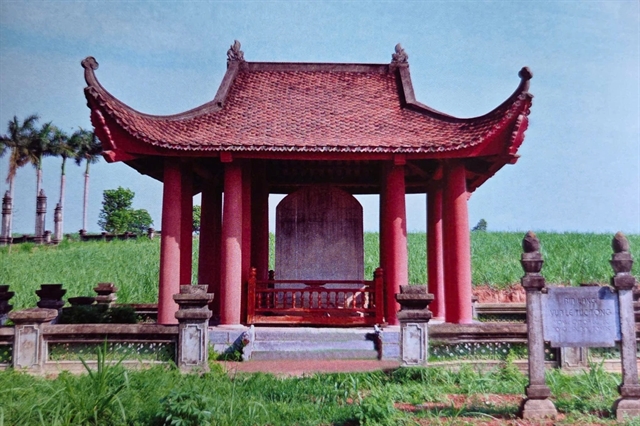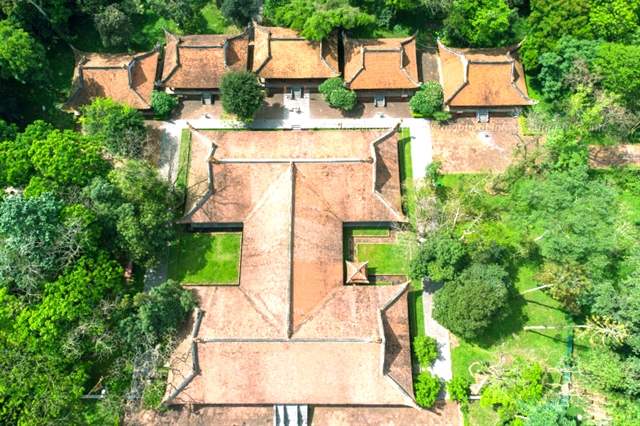 Life & Style
Life & Style

 |
| The tomb stele of Emperor Lê Túc Tông. — Photo courtesy of the management board of the Special National Heritage Site of Lam Kinh |
THANH HÓA — The Department of Culture, Sports, and Tourism of Thanh Hóa is calling for tougher measures to prevent and address vandalism and illegal excavation of royal tombs in search of artefacts.
The request follows an incident when Emperor Lê Túc Tông’s tomb, located in Kiên Thọ Commune, Ngọc Lặc District, showed signs of being vandalised.
According to the Department, several officials from the Thanh Hóa Centre for Historical Research and Heritage Conservation at around 9.30pm on May 3 discovered that the tomb had been desecrated.
At the site, authorities found a mobile phone with Chinese-language settings, several identity documents belonging to a Chinese citizen and a metal probing tool commonly used to search for buried artefacts.
The findings were promptly reported to the Thanh Hóa Province Police Department by the heritage centre.
The Quảng Ninh Police Department have apprehended the two suspects: Deng Zhui, 41, and Shen Jiangyang, 43. Both are residents of Guangxi Province in China. They were handed over to Thanh Hóa Province police for further investigation.
Strengthening protection
Following this, and the desecration of the tomb of Lord Nguyễn Phúc Khoát in the central province of Thừa Thiên-Huế on January 5, the Department of Culture, Sports and Tourism of Thanh Hóa noted that many localities are currently facing the issue of illegal vandalism and excavation of royal tombs in search of relics.
Criminals often exploit opportunities for tourism, scientific research and education in the field of cultural heritage to survey and engage in acts of excavation and vandalism at the tombs of historical figures and archaeological sites.
The department has requested local authorities to enhance the management and protection of historical and cultural sites, as well as scenic spots.
They also demanded prompt detection, prevention, and strict handling of theft, excavation, recovery, and illegal trading or exchange of relics and artefacts in the area.
Special attention should be given to equipping surveillance camera systems and lighting within the historical and cultural sites as well as scenic spots managed by the local authorities.
Thanh Hóa Provincial Police and relevant units are asked to investigate and clarify the incident, preventing acts of vandalism, unauthorised excavation and search for relics and artefacts at the tombs of Lê Emperors, including Emperor Lê Túc Tông’s, specifically within the Lam Kinh historical site.
This should also extend to the tombs of the Trịnh and Nguyễn lords, historical figures from various feudal dynasties, and archaeological sites throughout the province.
Lê Túc Tông (1488–1505), also known as Lê Thuần, was the third son of Emperor Lê Hiến Tông. According to the Đại Việt Sử Ký Toàn Thư (The Complete Annals of Đại Việt), the emperor was known for his virtuous character, respect for the wise and dedication to maintaining peace and stability throughout the realm
After passing away in 1505, his remains were interred at Kính Lăng in Lam Kinh, within the present-day bounds of Kiên Thọ Commune.
The emperor’s tomb was previously damaged, leaving only a few thin bricks arranged around a raised mound. It was restored in 1997. The new tomb measures 4.5 metres in length, 4.5 metres in width, and 1 metre in height.
The special national heritage site of Lam Kinh covers an area of over 200 hectares, located in the districts of Thọ Xuân and Ngọc Lặc in Thanh Hóa.
 |
| The aerial view of the special national heritage site of Lam Kinh that houses tombs of emperors, queens, and empresses of the early Lê Dynasty (1428-1528). — Photo courtesy of the management board of the Special National Heritage Site of Lam Kinh |
This site is the homeland of the national hero Lê Lợi, associated with the Lam Sơn uprising against the Ming invaders (1418-1427), and serves as the eternal resting place for emperors, queens, and empresses of the early Lê Dynasty (1428-1528). They include emperors Lê Thái Tổ (Lê Lợi), Lê Thái Tông, Lê Nhân Tông, Lê Thánh Tông, Lê Hiến Tông, Lê Túc Tông, and two empress dowager's - Ngô Thị Ngọc Dao and Nguyễn Thị Ngọc Huyên. — VNS